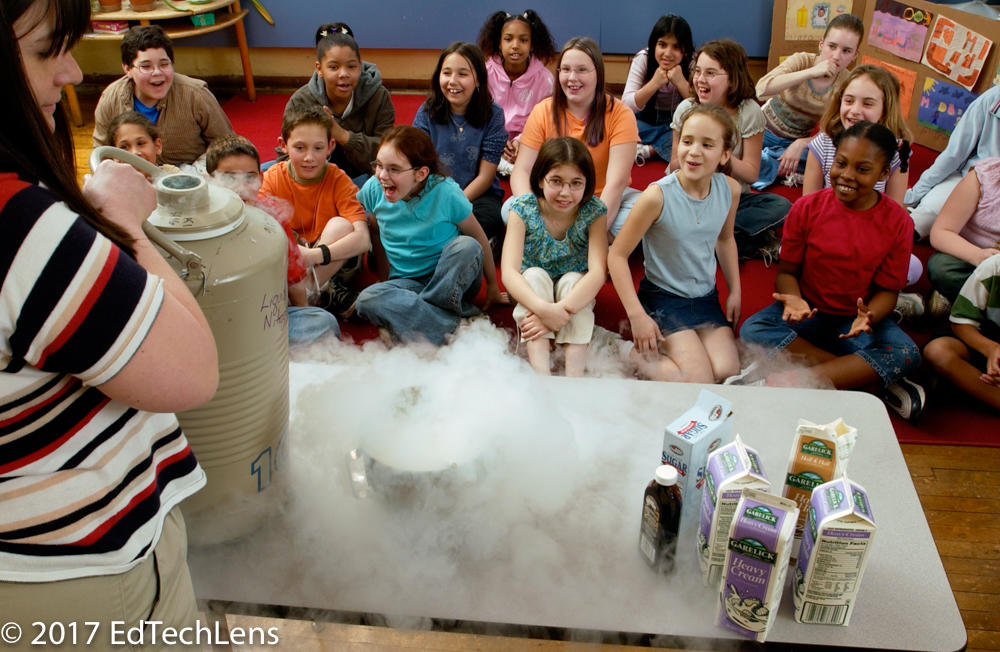
The Power of Discovery: What Neuroscience Teaches Us About Learning
The brain loves to learn, but it doesn’t respond well to being fed information, according to Dr. Judy Willis. “My advice for teachers is to start with the bang. There are amazing things to discover in science. For example, any child will be thrilled to see what happens when a rose is dipped in liquid nitrogen.”
By starting with the excitement – letting students see how an element with a boiling point of -320 degrees Fahrenheit freezes a rose into something that can be shattered – teachers spark students’ curiosity, says Willis, who was a practicing neurologist before becoming an educator. “Follow that demonstration with some questions about the difference between liquids and gases or what happens when molecules are heated and cooled, and you’re off. What’s key is to start by igniting curiosity. Don’t start by presenting information.”
The Risks of Rote Learning
After 15 years practicing as a board-certified neurologist, Willis became interested in how classrooms were changing when she noticed a sharp uptick in the number of school children being referred to her as patients. She began observing classrooms and noted the regimented teaching style. Students as young as first grade were seated in rows listening (or attempting to listen) to lectures and completing worksheets. Many were fidgeting, acting out, staring out the window, unable to focus. “And I know – brain science shows us – that the brain goes into a state of stress out of boredom, and a stressed brain does not learn.” Willis says. What she saw inspired her to get a degree in education so she could contribute to the development of teaching methods rooted in what neuroscience shows us about how the brain learns.
“Rote memory focuses on learning by repetition and recall of facts, rather than learning by understanding a subject,” she says. “The problem is rote learning is the most quickly forgotten because the information is not stored in long-term memory. Neuroimaging and new brain-wave technology show evidence for this.”
Students may remember a group of disassociated facts long enough to pass a test but if memorizing is the only way they interact with the material, these facts are inaccessible to the brain shortly after the test is over. But when kids’ brains hold onto memories as concepts, the information is not only accessible but understood as part of something larger. “Students who learn this way are the ones who will be ready for innovation,” Willis says.
Let Children Build Their Own Knowledge
Willis recommends creating opportunities for discovery and letting students be scientists. “Instead of teaching them about light refraction, hang crystals in the windows before they arrive to class. The rainbows splashed on the walls will ignite their curiosity,” she says. The next step could be setting up small groups to work with prismatic lenses as the foundation of an inquiry-based project about light and prisms.
Five Senses: Five Ways to Experience Science
“It’s important to give them opportunity to understand and interact with the subject through all of their senses,” Willis explains. Each of our senses is enabled by a different part of the brain so that when a subject is learned or practiced through multiple senses the memory is supported by multiple regions of the brain.
To show how learning through the senses improves students’ recall of a subject, Willis provides an example: “When students are learning about planets rotating around the sun, have them draw pictures that illustrate the solar system in orbit and then move around the classroom in an orbit. You can also assign them a video or a PowerPoint project in which they explain the orbital motions of planets. In each of these activities, they’re experiencing information through a different sensation and therefore using a different type of memory. Their brains are now holding numerous parts of a memory and all the parts are connected by dendrites. As soon as one is activated, all the other places in the brain where the info was stored are also activated. Students who have learned in this way will hear the term ‘solar system’ in the future and will remember moving in ‘orbit’ around the classroom along with all the other ways they experienced orbital rotation and the idea of the solar system. By learning through multiple senses, access to information increases and what has to be re-memorized decreases.”
Using Curiosity to Fuel Learning
Willis reiterates the power of discovery in education: “Letting children discover and experience subjects through experiments, demonstrations and field trips sparks curiosity which in turn fuels the interest and motivation necessary for learning. If you can set them up to draw on their own judgment and analysis to figure things out for themselves, you can take advantage of the brain’s neuroplasticity to ensure the memories they construct will be rich and lasting.”
The power of discovery is just one dynamic at play in the brain. Willis has published dozens of articles exploring the intersection between brain science and learning. Links to these pieces are available for free on her website.
Also, see this entry on the EdTechLens blog to read Dr. Judy Willis’s list of questions for igniting curiosity.
About Judy Willis, M.D. M.Ed.:
Dr. Judy Willis, a board-certified neurologist has combined her 15 years as a practicing neurologist with ten subsequent years as a classroom teacher to become a leading authority in the neuroscience of learning. She’s written seven books about applying neuroscience research to classroom teaching strategies and currently serves as adjunct faculty at the University of California Santa Barbara Graduate School of Education. She travels nationally and internationally giving presentations, workshops, and consulting about learning and the brain. She has been interviewed by USA Today, Euronews, The Wall Street Journal, NBC News Education Nation, ABC Australia Radio, Lateline Australia, Popular Mechanics, Neurology Today, USA Today, Education Week, and Parenting Magazine among others. In 2011 she was selected by Edutopia as a “Big Thinker on Education.”

